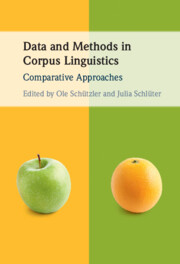Book contents
- Data and Methods in Corpus Linguistics
- Data and Methods in Corpus Linguistics
- Copyright page
- Contents
- Figures
- Tables
- Contributors
- Acknowledgements
- Introduction: Comparative Approaches to Data and Methods in Corpus Linguistics
- Part I Corpus Dimensions and the Viability of Methodological Approaches
- Part II Selection, Calibration and Preparation of Corpus Data
- Part III Perspectives on Multifactorial Methods
- 6 Comparing Generalised Linear Mixed-Effects Models, Generalised Linear Mixed-Effects Model Trees and Random Forests
- 7 Comparing Logistic Regression, Multinomial Regression, Classification Trees and Random Forests Applied to Ternary Variables
- 8 Comparing Bayesian and Frequentist Models of Language Variation
- 9 Comparing Methods for the Evaluation of Cluster Structures in Multidimensional Analyses
- Part IV Applications of Classification-Based Approaches
- Index
- References
8 - Comparing Bayesian and Frequentist Models of Language Variation
The Case of Help + (to-)Infinitive
from Part III - Perspectives on Multifactorial Methods
Published online by Cambridge University Press: 06 May 2022
- Data and Methods in Corpus Linguistics
- Data and Methods in Corpus Linguistics
- Copyright page
- Contents
- Figures
- Tables
- Contributors
- Acknowledgements
- Introduction: Comparative Approaches to Data and Methods in Corpus Linguistics
- Part I Corpus Dimensions and the Viability of Methodological Approaches
- Part II Selection, Calibration and Preparation of Corpus Data
- Part III Perspectives on Multifactorial Methods
- 6 Comparing Generalised Linear Mixed-Effects Models, Generalised Linear Mixed-Effects Model Trees and Random Forests
- 7 Comparing Logistic Regression, Multinomial Regression, Classification Trees and Random Forests Applied to Ternary Variables
- 8 Comparing Bayesian and Frequentist Models of Language Variation
- 9 Comparing Methods for the Evaluation of Cluster Structures in Multidimensional Analyses
- Part IV Applications of Classification-Based Approaches
- Index
- References
Summary
This chapter compares standard frequentist and more recent Bayesian approaches to logistic regression analyses. Starting out from a multifactorial case study of the verb help complemented by either the bare infinitive or the to-infinitive, the key components and the main conceptual differences of frequentist and Bayesian inference are discussed. Conceptually, the Bayesian rationale of directly testing hypotheses on the effects of multiple factors on an outcome variable is argued to be preferable and more sensitive than the conventional approach of testing null hypotheses. On the practical side, Bayesian statistics enables the researcher to recycle and integrate the results of previous analyses based on different datasets as informative priors, which can help improve and stabilize statistical modelling. Recourse to prior research can thus produce synergies and reduce data preparation expense. In cases of data sparsity, it can by the same token enable researchers to analyse small samples. Bayesian methods are thus put forward as powerful tools for overcoming the limitations of isolated corpus studies and for promoting synergies between data collected by individual researchers.
Keywords
Information
- Type
- Chapter
- Information
- Data and Methods in Corpus LinguisticsComparative Approaches, pp. 224 - 258Publisher: Cambridge University PressPrint publication year: 2022
References
Further Reading
References
Accessibility standard: Unknown
Why this information is here
This section outlines the accessibility features of this content - including support for screen readers, full keyboard navigation and high-contrast display options. This may not be relevant for you.Accessibility Information
- 9
- Cited by
